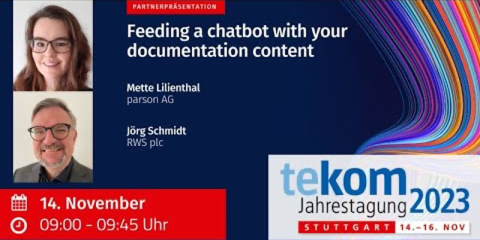Chatbots in customer service
Let your documentation do the talking
You have well-maintained, up-to-date documentation for your products or services that you provide to your customers and your service and support team. The search function allows users to find the information they need quickly and reliably. Now you want to add a chatbot that answers questions about your products and assists with problems. You want to free up your customer support team and make your customers even happier.
The chatbot should be able to directly access information from your company's technical documentation, service reports, or product data to provide accurate and up-to-date solutions.

Integrate chatbots for better customer service
We help you integrate corporate knowledge into a chatbot. We can evaluate and prepare your documents, knowledge articles, and technical documentation for chatbot delivery. We can also help you choose the right tools and help you set up and maintain your chatbot. This is how we work. This is how we work.
Your contacts
Chatbots in customer service
Our customers
Your chatbot with your data. This is how we work
Analyze documents. We analyze your documents to determine if they are suitable for a chatbot.
Prepare documents. We prepare documents, knowledge articles, technical documentation, and product information for chatbot delivery.
Develop content supply chain. We develop the content supply chain between information management systems and the chatbot. We help you choose the right tools for the supply chain.
Configure the chatbot. We create initial intents for the chatbot. Learn more about intents in chatbots in the FAQs.
Maintain the chatbot. We help you create additional intents and share our knowledge with your customer support team. If you wish, we can also provide long-term intent maintenance support.
Learn more about chatbots in customer service in the FAQs.
FAQs – Frequently asked questions about chatbots for technical documentation
How do chatbots work?
The term “chatbot” a contraction of the terms “to chat” and “robot”. Chatbots thus are robots which with one can chat. The procedure itself of how a chatbot works is rather simple: A user enters a text in natural language, which the computer then parses and translates into an action it can carry out, i.e., answering a question.
What’s the difference between a rule-based and an AI-based chatbot, and which is better suited for technical documentation?
In general, rule-based chatbots have possible responses pre-defined by the chatbot provider. Machine Learning-based chatbots calculate the response themselves based on trained AI language models. Rule-based chatbots are simpler as they follow pre-defined rules to respond to detected keywords. They work more accurately in small, more limited scenarios as the intents have to be defined manually. If the scope of a chatbot’s expertise is known, a rule-based chatbot makes more sense because the responses are pre-defined, meaning that the chatbot will only give users answers that have been deemed appropriate and correct by the chatbot provider.
Machine Learning-based chatbots are better-suited for scenarios in which the conversation flow cannot be clearly mapped or in which the scope is too extensive for a rule-based chatbot to manage. AI-supported chatbots work more flexibly due to their ability to ‘understand’ human language. As the responses are not pre-defined, AI-based chatbots are more suitable for creative tasks, such as writing assignments, than responses for which current, factual knowledge is required. They also achieve higher results in speech in long-term projects as it takes time to train them, but they then have an advantage in communication over rule-based chatbots as they sound more natural.
Although Machine Learning is often regarded as the more sophisticated and consequently better approach to chatbots, both Machine Learning and rule-based approaches are valid. Depending on circumstances such as time, finances and budgets, and complexity of the requirements, one approach might make more sense or be more suitable than the other, yet one cannot say one approach is generally superior to the other. What are the requirements for technical documentation to be accessible to a chatbot? The documentation has to be labeled in some form so that the chatbot knows which section of the documentation it should access. Depending on the complexity of the documentation, XML elements, or other simple forms of labelling can be enough; for extensive documentation, we recommend a metadata model so that the chatbot can, for example, also handle different variants of a product in its response. For processing in a chatbot, technical documentation should already be modularized, i.e. not be available as a large document. For example, the solution to an error message can be found more quickly if it is available as a text module and tagged with metadata such as error number and troubleshooting.
Where are chatbots already being used in technical documentation?
Mercedes-Benz AG provides an example of how technical documentation is linked to a chatbot. Mercedes Benz provides a virtual assistant with its Ask Mercedes chatbot. Ask Mercedes answers questions about the use of the vehicle, based on the information contained in the vehicle owner's manual. The chatbot is also available as an app and can be used via messenger services. Learn more.





